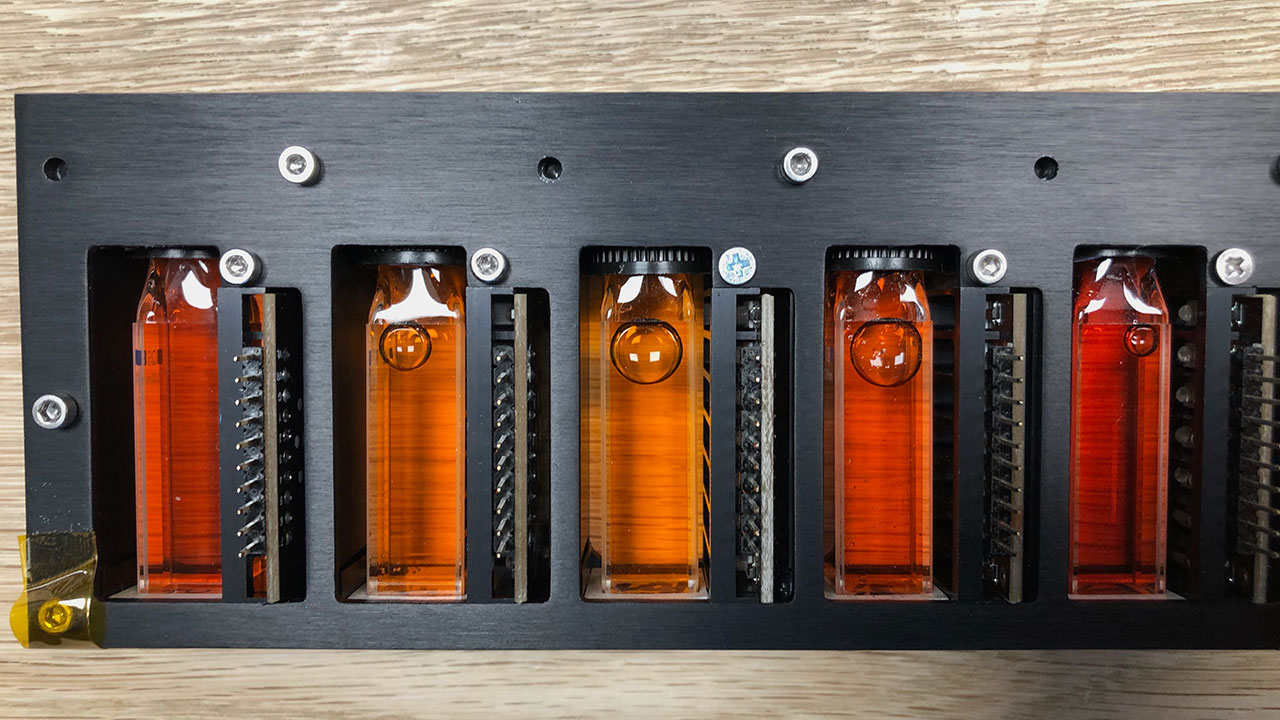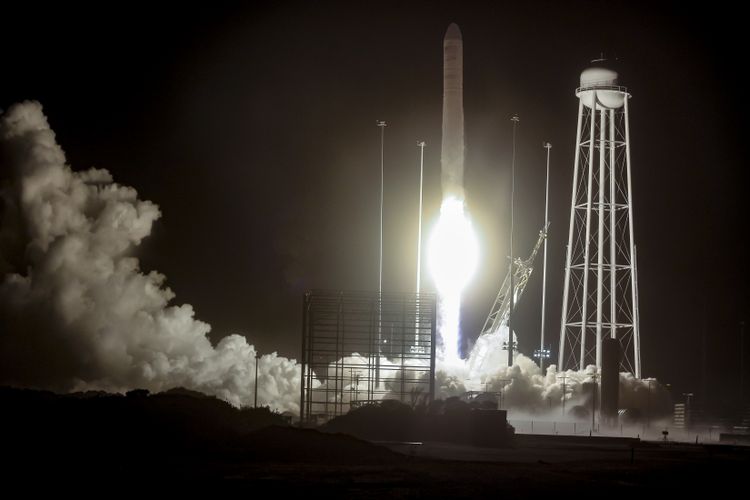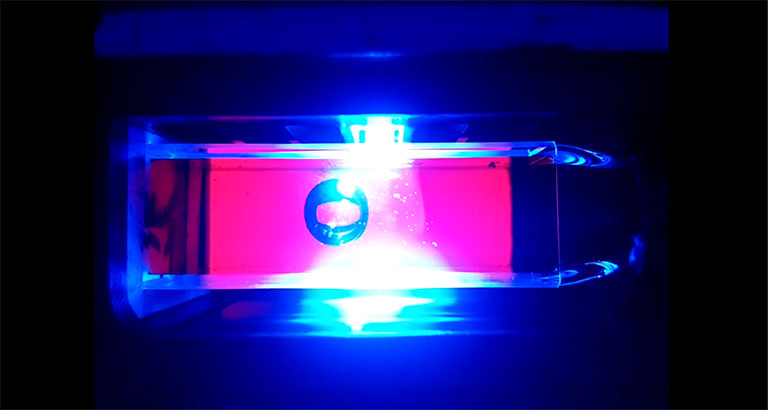Reshaping Clean-Energy Design With Space Bubbles

Five fluid-filled cuvettes prepared for launch to the ISS as part of the investigation.
Media Credit: Yangying Zhu
November 19, 2025 • By Stephenie Livingston, Staff Writer
By Earth’s standards, the bubble wasn’t supposed to move. But in a tube on the International Space Station (ISSInternational Space Station), aimless and weightless, it suddenly slid sideways, chasing the spotlight.
“It almost dances in and out of the light,” said Javier Read de Alaniz, an organic chemist at the University of California, Santa Barbara (UCSB). “So, as it shifts out of the light, it gets into a dark region, and it slows down. And then as soon as a tip touches light, it immediately moves toward that source.”
For the scientists who set out to move bubbles in microgravityThe condition of perceived weightlessness created when an object is in free fall, for example when an object is in orbital motion. Microgravity alters many observable phenomena within the physical and life sciences, allowing scientists to study things in ways not possible on Earth. The International Space Station provides access to a persistent microgravity environment. with nothing more than light, it was years of preparation condensed into a simple, elegant moment.
Controlling fluids in microgravity has long confounded scientists and engineers. Without gravity, bubbles don’t rise and escape; they cling to hot surfaces, forming an insulating layer that blocks heat. Droplets stick instead of sliding away, stalling the transfer of heat and fluids. Spacecraft cope with these quirks of microgravity by using workarounds that keep systems alive but add weight and complexity. What they can’t do is take advantage of efficient processes that make power plants, air conditioners, and even laptops work on Earth.
A camera onboard the ISS captures the bubble experiment, where light-responsive surfactants steer a floating bubble inside a cuvette.
Credit: Yangying Zhu
This ISS National Laboratory®–sponsored experiment, which was funded by the U.S. National Science Foundation (NSF), found a new way forward. Yangying Zhu and her team became the first to use lab-engineered molecules and light to drive fluid motion in microgravity—a breakthrough they unveiled at the 2024 APS Division of Fluid Dynamicsmeeting and described in a 2025 arXiv preprint. Zhu, a mechanical engineering professor at UCSB, says the approach shows how light can precisely steer fluids in space.
“We hope that the knowledge we learn from this ISS experiment will contribute to enhancing boiling heat transfer, both on Earth and in microgravity, enabling more efficient power generation,” she says. The same light-driven control could also inform cleaner energy design on Earth by laying the groundwork needed to move heat and fluids without pumps, cut energy losses in cooling systems, and build reactors that manage themselves.
This newfound fluid control could make spacecraft cooling systems lighter and more efficient, and the same principle may eventually transform technologies on Earth from data-center cooling to smart coatings that clean themselves at the flick of a light, says Read de Alaniz.
Engineering Bubbles
Apollo astronauts noted with some surprise that drops of water clung to cabin walls instead of falling. In the 1970s, Skylab hosted some of NASA’s first deliberate fluid physics experiments, where engineers tested how liquids wicked through narrow channels without gravity’s pull. Shuttle-era Spacelab missions expanded the work, building chambers to watch bubbles and droplets form, merge, and drift. By the 1990s, U.S. Microgravity Lab flights onboard the shuttle had revealed how surface tension alone could drive flows invisible on Earth, a phenomenon known as thermocapillary flow, or the Marangoni effect.
The ISS picked it up from there: Europe’s RUBI project studied boiling, NASA’s ZBOT tracked boiling in propellant tanks, and even Delta Faucet flew a droplet experiment through the ISS National Lab in search of better showers. In partnership with NSF, the ISS National Lab has sponsored several fluid dynamics experiments, providing researchers with the resources to test whether fluid behavior in space could be steered. In one such experiment, for example, a research team from Auburn University published results detailing how saw tooth-structured surfaces could be used to force the movement of bubbles in heat exchangers in microgravity.
For Zhu and co-principal investigator Paolo Luzzato-Fegiz, also a mechanical engineer at UCSB, that possibility began in a NASANational Aeronautics and Space Administration workshop in 2019. They listened as engineers described how boiling and condensation faltered in microgravity.
“In space, the bubbles are stuck on the surface. And they just accumulate, growing to larger, bigger-size bubbles,” Zhu said. For someone who studies how to move heat efficiently, the image was striking.
Traditional fixes were costly, fragile, and power-hungry, relying on etched surfaces or high-voltage electricity. Zhu sought a different solution.
“We like the idea of a system that can be actively tuned and requires no surface fabrication,” she said. “So, then we thought about using light.”
To coax bubbles, Read de Alaniz slipped photosurfactants into the liquid, molecules akin to the ones that let shampoo foam by easing tension between water and air. Think of a bubble as a balloon with molecules clinging to its skin. Shine light on one side, and those molecules loosen their grip.
When light of a certain wavelength hits the molecule, its structure shifts, changing from water-repelling to water-attracting and altering its shape, he explained. “And then when you take the light away, then it will revert back, in this case almost instantaneously, to its original form.”
On Earth, buoyancy seizes every bubble and lifts it before light can touch it. In space, that natural lift disappears. With nothing else moving the bubbles around, the tiny tug from light stands out. The team’s investigation was, at heart, a twist on the Marangoni effect, the same surface-tension phenomenon shuttle crews once probed with temperature differences in drifting droplets. Here, though, Zhu and her colleagues showed it could be harnessed—the difference is that the surface-tension gradient is generated by the photosurfactants that respond to light and steer fluids in space.
Groundwork for a Cleaner, Brighter Future
The hardware itself was simple: a CubeLab packed with fluids and a row of blue LEDs. “The tiny LEDs are very cheap, very low power,” Zhu said, as if the investigation rested on nothing more glamorous than dollar-store bulbs.
But when the CubeLab reached Space Tango’s facility in Kentucky for final integration, it refused to cooperate. Two of the team members and one of Read de Alaniz’s graduate students bought last-minute tickets, flew out, and spent frantic days coaxing it back to life so it could make the launch window.

Yangying Zhu, principal investigator and a mechanical engineering professor at University of California, Santa Barbara.
Media Credit: Yangying Zhu
Zhu never saw that launch in person. She was 35 weeks pregnant and couldn’t travel. The experiment and the birth of her child are twinned in memory, she says.
After the investigation launched in November 2022, the team hit a roadblock nearly as soon as it got to the station. A heater inside burned out, spoiling a planned boiling test. Then, astronauts sent a video clip from another test using light, one that changed the mood entirely. When the video was replayed, the bubbles moved, gliding toward the light.
“Being able to watch it in real time, I think, was probably the most remarkable thing,” Read de Alaniz said.
Tengfei Luo, a mechanical engineering professor at the University of Notre Dame who has also studied bubble dynamics on the ISS, called Zhu’s work a fundamental study that does something extraordinary by cleanly isolating the physics of bubble motion from the distorting effects of buoyancy and convection.

The team's investigation launched to the ISS on Northrop Grumman's 18th commercial resupply services mission(Abbreviation: CRS mission) A CRS mission is a cargo resupply mission contracted by NASA to deliver supplies and research to the International Space Station on commercial spacecraft as part of the CRS contract with three commercial companies. As part of CRS missions, experiments currently return to Earth on SpaceX Dragon spacecraft that splash down in the ocean. for NASA.
Media Credit: Northrop Grumman
“The team’s methodology might help detach the bubble from the surface or guide substances from one place to another for chemical reactions or biosensing,” he said, applications that could eventually aid heat transfer or robotic microfluidics experiments.
In the next iteration, Luo suggests testing different photosensitive molecules or light wavelengths, exploring how liquid viscosity shapes the effect, or even combining light-driven motion with surface interactions. Each variation, he says, would reveal another layer of how bubbles behave in space.
“The good thing about the ISS National Lab is that it not only funds specific applications, but also fundamental work like this project,” Luo added. “The impact will be further amplified by the community, which can leverage the fundamental knowledge for diverse applications.”

A bubble hovers inside a transparent cuvette as a beam of light strikes the fluid.
Media Credit: Yangying Zhu
Seeing was believing for Read de Alaniz. “Seeing the droplet in the center of a cuvette with no gravity and then controlling it from thousands of miles away, you know, I think really speaks to what the potential could be,” he said.
Luzzatto-Fegiz has used the video to develop theoretical models of fluid flow driven by photosurfactants. “The absence of gravity makes it possible to rigorously test our models,” he says, “which then can be applied to other, general flows.”
For Zhu, it also serves as inspiration. “I have undergraduate students basically saying that they want to do space-related research in the future after they see this experiment,” she says.
The same light-responsive molecules that nudged bubbles on the ISS could one day inform new ways of making surfaces behave differently on demand. Read de Alaniz pointed to “smart” coatings that reset with a flash of light, creating surfaces that could shed buildup or toggle from sticky to slippery on demand. In industry, that could mean reactors that clean themselves, membranes that don’t clog, or energy systems that restore with light—technologies that make energy production and heat management cleaner by design.
Luo agreed that such control could eventually be possible, though he emphasized that the study’s strength lies in understanding the fundamentals of how light drives motion in weightlessness, which is knowledge others can build on.
As Zhu put it: “If you understand a process fundamentally, that opens up doors to not just one thing, but maybe ten other things.”
It’s how, after decades of watching bubbles misbehave in space, someone finally got one to listen.